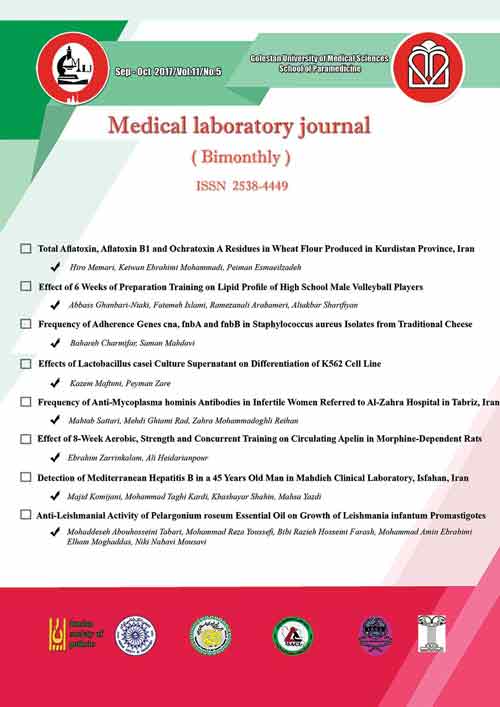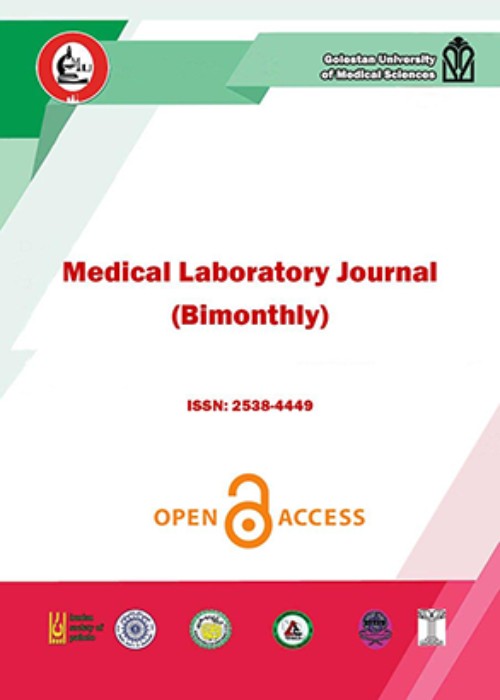فهرست مطالب

Medical Laboratory Journal
Volume:11 Issue: 5, Sep - Oct 2017
- تاریخ انتشار: 1396/08/07
- تعداد عناوین: 8
-
-
Pages 1-6Background And ObjectivesContamination of food products with mycotoxins is a public health problem. The International Agency for Research on Cancer has identified mycotoxins as hepatotoxic and carcinogenic agents to humans (Group 1). The Kurdistan Province is the ninth largest producer of wheat in Iran. We aimed to determine the level of contamination with total aflatoxin (TAF), aflatoxin B1 (AFB1) and ochratoxin A (OTA) in 66 wheat samples randomly selected from 11 wheat flour factories in spring and summer.
MethodsThe level of toxins was measured by microtiter plate enzyme-linked immunosorbent assay (ELISA) using a microtitre plate ELISA reader and total AF, AFB1 and OTA commercial kits.
ResultsOverall, the level of TAF and AFB in 16.67% of the samples exceeded the maximum tolerable limit set by the Institute of Standard and Industrial Research of Iran (ISIRI). However, the level of OTA contamination did not exceed the maximum tolerable limit set by the ISIRI. In addition, the level of TAF, AFB1 and OTA exceeded the maximum tolerable limit set by the EU in 68.18, 90.91 and 36.36% of the samples, respectively. The level of contamination with these mycotoxins differed significantly in spring and summer (PConclusionThe level of mycotoxin contamination in wheat samples produced in the Kurdistan Province is alarmingly high and appropriate measures should be taken to eliminate the causes of this issue.Keywords: Aflatoxin, Aflatoxin B1, Ochratoxin A, Wheat, ELISA -
Pages 7-10Background And ObjectivesThe aim of the present study was to investigate the effect of six weeks of volleyball training on lipid and lipoprotein profiles of elite high school male volleyball players in the Golestan Province (Iran) during preparation season for an international championship in France.
MethodsTraining group included 12 elite volleyball players in students premier league and control group included 12 healthy non-athlete male students. The training group practiced at 60-85% of maximum heart rate for six weeks, 90 minutes per session, six sessions per week and three sessions a day (first session: technical practice, second session: tactical practice and third session: technical/tactical practice). Blood samples were taken after 12 hours of fasting both before and after the training.
ResultsLevel of total cholesterol (TC), high-density lipoprotein-cholesterol (HDL-C), low-density lipoprotein-cholesterol (LDL-C) and LDL-C/HDL-C increased in the training group (P> 0.05). However, there was a significant difference between the two groups in TC and LDL-C levels (P 0.05).
ConclusionOur results show that the six-week volleyball training during the preparation season can cause abnormalities in plasma lipid profile.Keywords: Lipid, Lipoprotein, Volleyball Player -
Pages 11-15Background And ObjectivesSeveral virulence factors are involved in the pathogenesis of Staphylococcus aureus. Surface proteins such as collagen binding proteins (Cna) and fibronectin-binding proteins (FnBP) are important factors in adhesion and invasion of S. aureus. The aim of this study was to evaluate the frequency of adherence genes cna, fnbA and fnbB S. aureus isolates from traditional cheese.
MethodsAll 22 isolates tested were identified as S. aureus. The isolates were tested for the presence of adherence genes cna, fnbA and fnbB using specific primers in polymerase chain reaction assay.
ResultsSix isolates (27.27%) were positive for the can gene. Of the 22 isolates studied, one isolate was positive for fnbA and one was positive for the fnbB. Co-presence of the genes examined was not observed in any of the isolates.
ConclusionThe results indicate the weak biofilm formation ability of the S. aureus isolates from traditional cheese.Keywords: Staphylococcus aureus, Biofilm, Genes, Cheese -
Pages 16-21Background And ObjectiveConsidering the toxic side effects of chemotherapy in treatment of cancer, anticancer drugs of natural origin including probiotic Lactobacillus strains have recently attracted a lot of attention.MethodsAfter culturing chronic myeloid leukemia cell line K562 in 96-well plates, effects of different concentrations of culture supernatant from Lactobacillus casei on differentiation of the cells were investigated after 48 and 72 hours under an inverted microscope. Number of live cells and percentage of viable cells were determined by trypan blue exclusion test of cell viability. Cytotoxicity was assessed by MTT assay. Data analysis was performed by SPSS (version) 22 using one-way analysis of variance and Tukey's test at significance level of 0.05.
ResultsSecondary metabolites from the probiotic bacteria L. casei induced cellular differentiation, exerted anti-cancer effects and inhibited growth in K562 cells. Apoptotic cell death was confirmed by MTT and DNA fragmentation assays in a way that increasing the dilution from 1.2 to 1.32 significantly increased the viability of cells (P=0.001). In addition, increasing the dilution significantly increased the number of live cells in the first 48 hours (P=0.001).
ConclusionCulture supernatant of L. casei reduces the number of live cells, and induces apoptosis and monocytic differentiation in K562 cells in a dose- and time-dependent manner. Therefore, combined chemotherapy and differentiation therapy using such supernatants could be useful for treatment of cancer.Keywords: Cell differentiation, K562 cell line, Probiotic, Lactobacillus casei -
Pages 22-26Background And ObjectivesInfertility is one of the important causes of anxiety in couples. Infections caused by genital Mycoplasmas may have harmful effects on the reproductive health of women, and sometimes lead to infertility. This study was designed to determine frequency of anti-Mycoplasma hominis antibodies in infertile women at Al-Zahra Hospital, Tabriz, Iran.
MethodsIn this cross-sectional study, serum from 184 infertile women and 100 healthy pregnant women were tested for presence of M. hominis IgM and IgG antibodies by ELISA. Data collected were analyzed in SPSS (version 17) using t-test at significance level of 0.05.
ResultsThe frequency of anti-M. hominis IgG was significantly higher in infertile women compared to healthy controls. The frequency of anti-M. hominis IgM did not differ significantly between the infertile and control subjects. The majority of the women infected with the bacterium were in the 21-30 and 31-40 years age range. There was no significant correlation between tubal factor infertility and seropositivity for M. hominis antibodies. Moreover, the dwelling of the participants had no relationship with the frequency of anti-M. hominis antibodies.
ConclusionThe frequency of Èowed that a high percentage of t a high percentage of that the meaninngful le women was 4% and infertile women infected with this bacterium is high in Tabriz. Therefore, it is important to perform microbial screening for this bacterium in infertile couples.Keywords: Mycoplasma hominis, Infertility, Women, Tabriz -
Pages 27-32Background And ObjectivesPrevious studies have shown that morphine dependence leads to myocardial dysfunction. In addition, apelin plays a protective role in cardiac function. The purpose of this study was to evaluate effects of morphine dependence and three models of exercise training on serum apelin level of dependent and healthy rats.
MethodsTen healthy and 40 morphine-dependent rats were used in this study. The morphine-dependent rats were divided into four equal groups of control addicts, endurance training, strength training and concurrent training. The training exercises were carried out for eight weeks, five days a week. Serum apelin level was measured by ELISA, 72 hours after the last training session.
ResultsStatistical analysis demonstrated that apelin level increased significantly in morphine-dependent rats compared to healthy controls. On the other hand, endurance and concurrent training significantly increased serum apelin level in morphine-dependent rats compared to control addicts, but strength training had not effect on serum apelin level in morphine-dependent rats.
ConclusionEndurance and concurrent training may have cardioprotective effects on morphine-dependent rats by increasing serum apelin levels. Therefore, such training activities could be recommended to morphine-dependent patients to prevent cardiac disorders.Keywords: Apelin, Morphine, Exercise -
Pages 33-35Three major hepatitis B virus (HBV) antigens include HBcAg, HBeAg and HBsAg. HBeAg is the extracellular form of HBcAg, and is seen almost exclusively in people who have circulating serum HBV DNA. Presence of HBsAg in serum indicates that the individual has contracted HBV infection. Chronic hepatitis HBeAg-negative/anti-HBepositive is known as an important form of chronic hepatitis B in the Mediterranean region. In this report, we used Real-Time PCR and ELISA for detection of HBV and HBeAg/HbsAg, respectively. In our investigation on 4743 HBV cases referred to the Mahdieh Clinical Laboratory between 2008 and 2016, we found a 53-year-old man with clinical symptoms of hepatitis and abnormal molecular and serological features. Despite the presence of clinical symptoms and high viral load (128 × 105 iu/ml), the patient was HBsAg-positive and HBeAg-negative. Identifying this type of HBV could indicate spread of this type of hepatitis in Isfahan, Iran.Keywords: Hepatitis B, HbsAg, HBeAg
-
Pages 36-40Background And ObjectivesDue to adverse effects of pentavalent antimonial treatment of visceral leishmaniasis using herbal medicines has received a lot of attention. In this study, we evaluated inhibitory activity of Pelargonium roseum essential oil on growth of Leishmania infantum promastigotes, and compared it with that of Glucantime.
MethodsInhibitory effects of different concentrations (1, 2.5, 5, 10, 25, 50 and 100 µL/ml) of P. roseum essential oil on the growth of L. infantum promastigotes were studied by MTT assay after 24 and 48 hours. All the data were analyzed by one-way analysis of variance. The effect of the essential oil was later compared with that of standard dose of Glucantime.
ResultsAfter 24 hours, different concentrations of the essential oil had no significant inhibitory effect on promastigotes of L. infantum. After 48 hours, all concentrations except for 1µL/ml showed significant anti-leishmanial activity. In addition, the lowest concentration that had significant inhibitory effect on L. infantum promastigote was 5 µL/ml.
ConclusionThe essential oil of P. roseum has favorable inhibitory activity on the growth of L. infantum promastigotes after 48 hours. This indicates the therapeutic potential of this plant for treatment of leishmaniasis.Keywords: Leishmania infantum, Pelargonium, Promastigote, Meglumine antimoniate


